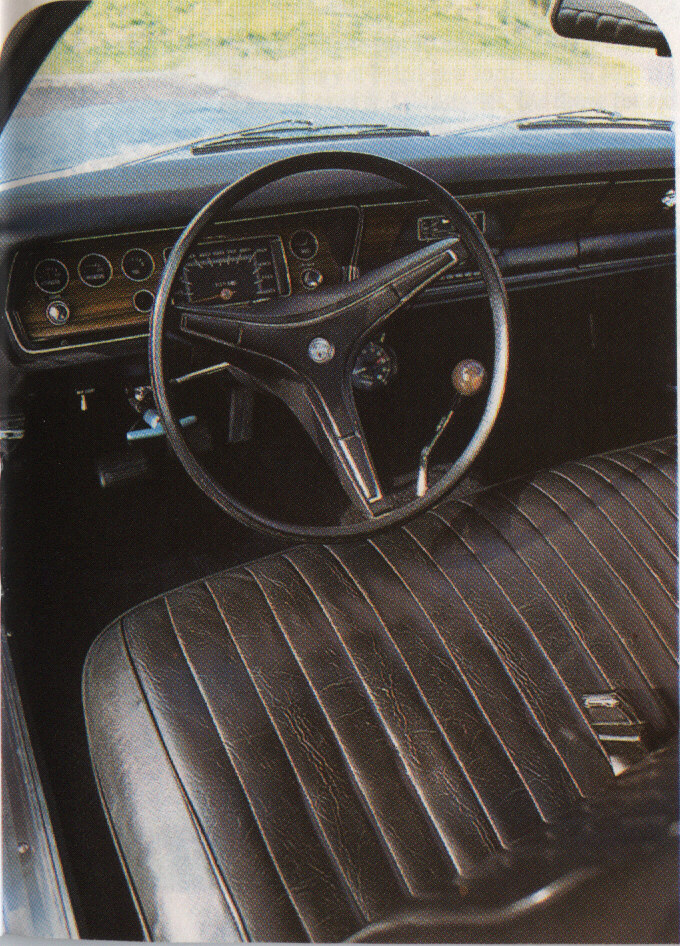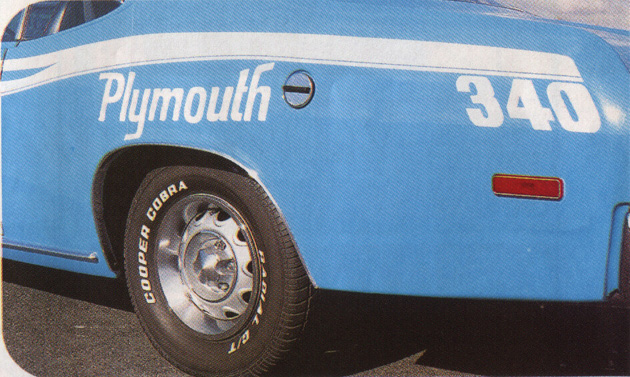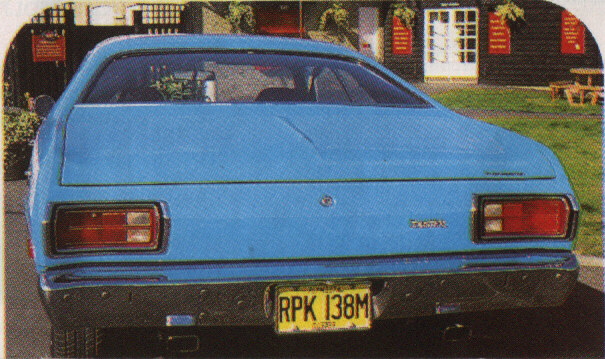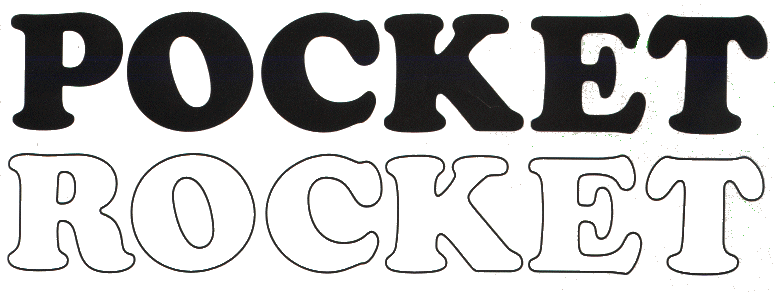
In the early seventies, Plymouth offered
performance in an economy package in the shape of the Duster 340. PAUL BUSSEY caught up with a Kent-based fan of Plymouth's pocket
rocket.
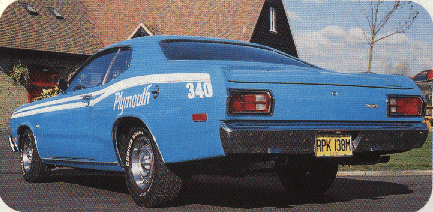
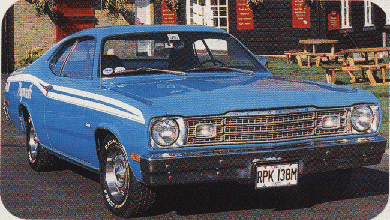
Words and Photography PAUL BUSSEY
"STEVE'S IDEA OF HOW THE CAR SHOULD LOOK INCLUDED HIM
FITTING A SET OF CHROME WHEELS, FULLY CHROMING THE ENGINE BAY, AND A STRAIGHT
THROUGH CHERRY BOMB EXHAUST SYSTEM!"
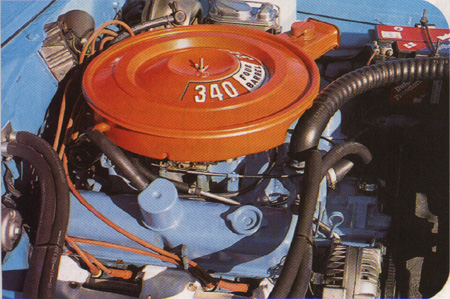
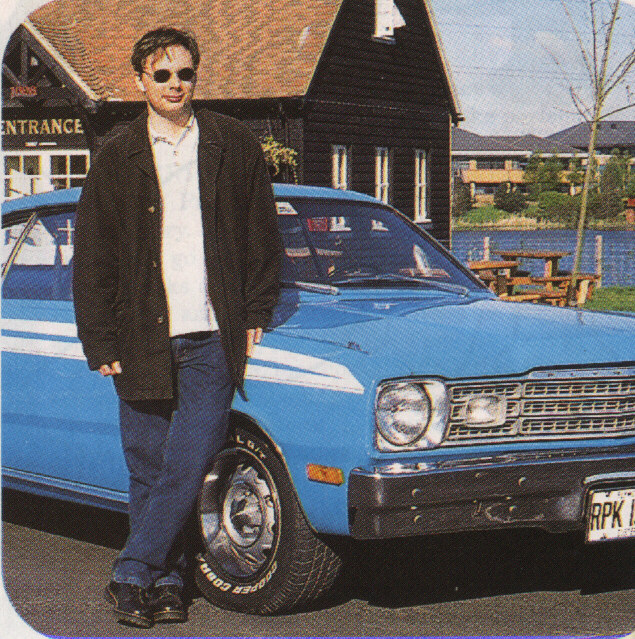 340cu.in. MAKES 275BHP
340cu.in. MAKES 275BHP
A VERITABLE feast of
mouthwatering Mopar muscle cars was available to the discerning performance
minded enthusiast during the late Sixties and early Seventies. Those were the
days when Chrysler's commitment to the ultimate in power and speed was
whole-hearted.
However many of Chrysler's
more mundane offerings did not always benefit from the limelight of their more
glamorous stablemates; nonetheless, these cars still enjoy an enthusiastic
following in their own right today. One such car is owned by Kent postman
Steve Bainbridge, a 1973 Plymouth Duster 340 Sports Coupe,
imported into the UK from Oregon in 1988 by RPM (Rare Performance Motors), of
Aldershot, Hampshire.
Introduced in 1970
as a roomy Sports Coupe with semifastback styling, the Duster formed part of
Plymouth's compact Valiant/Scamp line-up, its sister Dodge offering, was the
Demon, which became the Dart Sport in 1973 (apparently the satanic overtones of
the Demon were too much for some good Christian Mopar-buyers!).
Production of the
Duster lasted until 1976 and was then dropped for two years before being
reintroduced in 1979 as part of Plymouth's Volare model line-up. The Duster was
initially offered with a 198cu.in. slant-six base engine, rated at 125bhp, or
an optional 225cu.in. slant-six, or a 318cu.in. V8. The top-of the-range engine
was a 340cu.in. V8 rated at 275bhp, which was later superseded by a 245bhp,
360cu.in. V8 in 1974.
Transmissions
available were a three-speed TorqueFlite automatic and three or four-speed
manual 'boxes. The Duster was seen as a reasonably priced ($2822 for Steve's
340 new in'73), economical car, offering spirited performance with the
340cu.in. engine and accommodation for up to five people.
It shared the same
front-end styling as the Valiant, as well as the dashboard. Over the years
variants included a Space Duster whereby the rear seat folded forward for extra
luggage capacity (up to six-feet long), a Gold and Silver Duster Custom Duster,
Duster Twister and would you believe, even a feather Duster?!
The latter was
introduced in 1976 and with economy very much in mind; it featured an aluminium
trunk lid, hood, inner panels, bumper reinforcements, intake manifold,
transmission case, and boasted 24mpg around town and 36mpg highway driving.
Built at the Hamtramck assembly plant, Michigan, Steve Bainbridge's Duster
features the more desirable 340cu.in. V8 engine with a useful 3401b.ft. torque
at 3200rpm. It also has the four-speed A833 manual box, with a Hurst shifter
and is a matching-numbers car. Running gear includes heavy duty suspension with
torsion bar at the front and six leaf springs at the rear, 8-inch rear axle
with 3.21:1 ratio, power front disc brakes, 15-inch Rallye wheels, and a dual
exhaust system. Inside standard equipment includes a split front bench-seat in
black vinyl, carpets, front and rear
arm-rest, woodgrain instrument
panel and door trim, deluxe steering wheel and A-pillar mouldings.
Steve's car was
originally sold to a GI through the military sales bank. Chrysler did
favourable deals through the US military where GIs could take advantage of
savings schemes promoted by the US government. With the lighter A-body
(32001bs) and 240bhp on tap, the Duster 340 represented quite a fast car for an
economy model. Total production of Dusters for 1973 was 15,731. Back in 1984
when Steve Bainbridge was 18, his enthusiasm for owning an American car was
whetted by reading running reports in Street Machine magazine and by watching
road movies on television. At the time he had visions of cruising around in
something like a Trans Am, but his insurance company was not quite so keen,
judging by the hefty premiums they quoted him! So his dream of American car
ownership had to be put on hold for the next five years until 1989 when his
burning desire for a Yank could not be contained any longer `By now I'd gone
off the idea of a Trans Am,' says Steve. `I'd always liked Mopar muscle cars,
but models like the Chargers, Challengers and Cudas were beyond my budget. I
did go and look at a late Sixties Chevrolet Impala in Dover, but unbeknown to
me, it was finished in an outrageous pink metalflake paintwork complete with `The Beast' graphics, if I remember rightly, which came as a bit of a shock and it just didn't appeal at
all!
The Duster was in
fact only the second car I viewed and was sourced from the American Car
Exchange at Farnborough, Hampshire. To be honest, patience is not my greatest
virtue and I'm no good at waiting for things, so I had the money available,
badly wanted to buy a car and the Duster was the only car they had that I could
afford!
Steve liked its
styling, it drove well and so he bought it. In hindsight he admits he probably
should have really done his homework on the model and had it fully checked out
beforehand. It could have turned into a real disaster, but luck must have been
on his side that day, as he's owned the Duster now for ten years.
`When I drove it
home for the first time I floored the accelerator on the M25 and it scared the
hell out of me, as I quickly saw 1l5mph on the speedo and thought, hold on,
better slow down a little!'
Apart from a few
scratches and one or two knocks, the car's bodywork, finished in the vivid
colour of Basin Street Blue, with white decals, was in pretty good shape.
Sadly, six months later Steve was made redundant from his job and reluctantly
the Duster was advertised for sale. `The response I had from the ads was awful
and I didn't receive a single call,' Steve recalls. `I'm glad about it now
though, fortunately I got a job with the Post Office and the Duster didn't need
to be sold.'
Steve's idea of how
the car should look included him fitting a set of chrome wheels, fully chroming
the engine bay, and a straight-through cherry bomb exhaust system! He's also
entered it at the `Run What Ya Brung' events at Santa Pod where his best time
was a 15.7 seconds over the quarter mile. He hastens to add though, `I never
could get the car to run properly down the strip, as the engine would lean out,
misfire and cut out. A realistic time should have been around 14 seconds.'
Having used the
Duster as his daily driver for four or five years, it was beginning to look a
little tatty in places, especially behind the rear wheel arches. It was time
for some major bodywork. However, Steve couldn't afford to carry out any major
mechanical work should he `over-do it' down the strip as well. It was hard, but
he made the decision to just use the car for static shows after the resto,
ending its days of competing against the clock.
The body repairs
included new repair sections behind the rear wheel arches and a respray in
two-pack, entrusted to Intensive Care, run by John Clayden in Erith, Kent.
Steve also decided to return the car to near original specification, so all the
braided hoses and the multitude of chromework under the hood were replaced with
stock components.
`I had to keep all
the parts that I had removed anyway,' he says, `so it was just a matter of
cleaning and painting where necessary before refitting. The cherry bomb exhaust
system had to go as well, and the chrome wheels too, replaced with original
Rallye wheels.
`I currently run
205-70-14 tyres on the front and 225-70-14 on the rear in order to fill the
wheel arches out a little, smaller tyres look a bit too skinny at the back. I
have since discovered that the white Plymouth script on the sides of the body
was not an original feature, though I quite like the effect and will probably
retain them as they are painted on and not decals.
`The 340 numbers
were however original on some Dusters. The bumpers which have been rechromed should
have overriders fitted to them, but I think they spoil the lines of the car and
prefer to leave them off.'
A stalwart member of
the Mopar Muscle Association (137 Borough Road, Petersfield, Hampshire, 01730
268375), Steve had MMA president Tony Oksien decode the fender tag and
broadcast sheet found under the rear seat, which confirmed that his car was
indeed a fine genuine example of the marque.
Over the ten years
Steve has owned his Duster, he's found it fairly practical to use as a daily
driver, though with its bright paintwork and body script making it conspicuous,
his main concern was leaving it parked just anywhere, in case of theft or
vandalism. Fortunately it has survived unscathed. Apart from changing a burnt
valve and a couple of clutches, the car's serviceability record has been quite
exemplary and its exhaust emits the most endearing mellifluous burble!
`I've always been
delighted with my Duster, it's pretty quick, and relatively cheap to run. Then
there's exciusivity too, as there are not many around nowadays; it's even won
several awards at shows,' enthuses Steve. Clearly a fine example of man and
machine in perfect harmony.
|
|
ORIGINAL RALLYE WHEELS LOOK THE PART
REAR BUMPER
OVERRIDERS WERE REMOVED TO KEEP THINGS SIMPLE |
|
Photographic location by kind permission of
`The Wharf' public house, Cotton Lane, Crossways Business Park, Dartford, Kent.
E-mail Steve Bainbridge the owner of this fine car if you have any questions or comments.
Magazine article courtesy of Classic American magazine available third Thursday of the month from all major newsagents.
